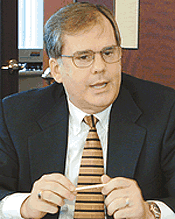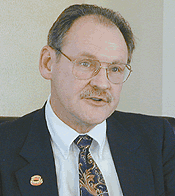Raising Pay Urged to Attract Drivers
 | |
| More coverage | |
| |
 |
“We have to invest heavily in higher wages,” he said. “We are upgrading equipment dramatically and very quickly, which has led to higher costs. We have new technology — part of it is customer demand and part of it is to retain drivers.”
A shortage of drivers is hampering growth and could lead to a shortage of freight hauling capacity, Smith said at TT’s forum.
Todd Spencer, executive vice president of the Owner-Operator Independent Drivers Association, said motor carriers have to do more than just talk about the problem.
“Thirty-five thousand dollars a year is not enough to keep most people from choosing another lifestyle or leaving this industry after a few months or maybe a few years,” he said. “Trucking wages clearly have not kept up, and it is worse than most of us want to admit.”
In addition to higher pay, Spencer called on carriers and shippers to find ways to reduce the 30 to 43 hours a week drivers spend waiting to load and unload. He also urged them to give big rig operators the respect they deserve.
 Michael James - Transport Topics |  |
| CRST Intl. President John M. Smith |  |
“Because of DOT regulations, age 21 is the first that you can bring [young adults] into the industry, which means they have already had one or two jobs beforehand, and they have been in different industries,” Smith said.
“We would like to take someone out of high school and begin training them into the industry and get them going earlier.”
Spencer disagreed with that approach.
“I think we run a real risk of degrading safety when we do that,” he said. “Years ago, you couldn’t get a job with a major carrier in trucking unless you were 25 years old. When you look at the accident statistics, you understand why.”
According to a 1998 report from the National Highway Traffic Safety Administration, drivers between the ages of 16 to 24 were more prone to be involved in fatal and injurious crashes than older adults. In the “drivers in all crashes” category, 16- through 20-year-olds accounted for 15,299 crashes for every 100,000 licensed drivers and those ages 21 to 24 had 10,211 accidents.
Most people who enter the industry as owner-operators are 24 or 25 years old, Spencer noted. “They have done some other things. They come in because they see an opportunity that they didn’t have previously. Right now, the opposite is happening. There are abundant opportunities in many, many other areas.”
Given the hardships and sacrifices inherent in over-the-road trucking, it is not surprising that many people are choosing other occupations and careers. But money is still at the heart of the matter, he said.
 |  Michael James - Transport Topics |
 | OOIDA Executive Vice President Todd Spencer. |
“But now we are talking about people who work very, very hard year-round for only slightly above-average earnings, and the sharp people are the ones that we lose. They can see the rewards just aren’t there.”
With proper training, Smith insisted that young people can learn to drive safely and are better suited for life on the road.
Most owner-operators start out as company drivers. Half of the trucks at CRST International are run by independent contractors.
“One of the things that we try to sell new entrants into our industry is that we have a career path here in which you can start out as a driver and come up as a team driver, as a trainer and, then ultimately, as an independent contractor,” Smith said.
He said owner-operators at his company are used primarily to haul iron and steel commodities, because that is a segment in which customers will pay less and equipment utilization is relatively low. Owner-operators are paid a percentage of the load’s value compared with company drivers who are generally paid by the mile.
“Where you don’t have as many miles, we can’t afford to have company trucks,” Smith said. “On the other end of the scale, where we’ve got team drivers in the long-haul business, it is more advantageous for the company to have trucks.”
On the issue of driver compensation, he said, “people have this mistaken idea that carriers set pay. The marketplace sets it. It is set by what our customers are willing to spend with us. It’s a supply-demand factor.
“When deregulation came in 1980, I will agree that relative driver pay came down tremendously and capacity was created. We had to get a lot more efficient and a lot of different things happened. I don’t think deregulation was totally on the backs of drivers, but there is no question that the relative pay has gone down and the marketplace just won’t allow it [to go up].”
 |
“I think we’re starting to see that change for the first time,” he said. “I think the supply of equipment is such that [in 2000], we are going to be able to go in and talk to our customers about the reality of the situation, and if we are going to provide them with the capacity they need, we are going to need more money and most of it is going to go to the driver.”

